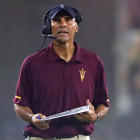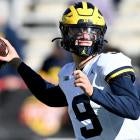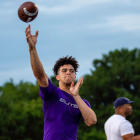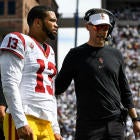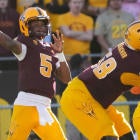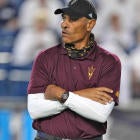
If your first reaction to Arizona State replacing Todd Graham with Herm Edwards a year ago was confusion, don't worry, you were far from alone. It was a bad joke, right? Either way, there was a lot of snickering going around.
Herm Edwards? Herm Edwards? The walking, talking meme with classics such as "you play to win the game!" who's been out of coaching for 10 years (and out of the college game, which he barely dabbled in at San Jose State, for far longer)?
Arizona State framed the hire as a restructuring of their athletics hierarchy with buzzy marketing phrases like "new leadership model," "CEO" and "NFL approach." To be sure, it's not uncommon for college coaching staffs to utilize the figurehead moniker, but it's typically with someone who is, you know, actively coaching.
The joke continued during Edwards' opening press conference and the weeks that followed. While no coach has ever lost his first presser, Edwards' was interesting and borderline awkward to say the least with some legitimately questioning whether he knew where he was coaching and if he had any idea what the college game was even like.
Anyone want to tell him? pic.twitter.com/ugrpCVNBY6
— FootballScoop Staff (@FootballScoop) December 4, 2017
Herm Edwards: "Is that a girl's jersey?"
— Doug Samuels (@CoachSamz) December 6, 2017
ASU employee: "No...This is a game jersey"
Herm: "This is a GAME JERSEY?!?!?"
(this exchange actually happened)https://t.co/d2cUWjVghW pic.twitter.com/F3gjz2ENaT
Yes, a lot of us had fun at Edwards' signature soundbites for the first month or so. But something has changed the tune in the past few months: The Sun Devils have been winning. ASU had a win total at five before the season and were picked dead last in the Pac-12 South. Only Colorado and Oregon State had lower win total projections in the Pac-12.
With two regular season weeks remaining, however, the 6-4 Sun Devils have already surpassed that total and are in the driver's seat to win the Pac-12 South. Up next are road games at struggling Oregon and then Arizona. Given the recent revival of Wildcats quarterback Khalil Tate, the Territorial Cup could low-key be one of the more entertaining and meaningful rivalries with divisional implications.
So how did Edwards, of all people, get his team to this point?
The offense is better utilizing its playmakers
Making wholesale in-season adjustments are rarely easy, but ASU has seen an improvement in offensive efficiency since moving to a more ground-based attack in late September. Offensive coordinator Rob Likens, promoted to play-caller following Billy Napier's departure to Louisiana-Lafayette last December, has taken Edwards' big-picture suggestion and made the most out of it.
The results didn't show at first as ASU lost four of five games during its midseason stretch in late September into October. However, every loss was by a single touchdown. Now, the results speak for themselves. Arizona State leads the Pac-12 in 6.33 yards per play and 5.29 yards per rush against conference opponents (the Sun Devils began implementing their offensive changes in a 27-20 loss to Washington in Week 4). They also lead the Pac-12 with 54 carries per game in November -- a difference of nearly +20 carries per game from September. Points per game has jumped up 10 points as well from 24 in October to 34.5 this month.
The advanced analytics like ASU's new-look offense, too. The Sun Devils rank 21st in success rate by S&P+ while hovering in the 20s and 30s for most offensive categories -- not elite numbers but respectable nonetheless. They're not super explosive (though they do lead the Pac-12 in rushes of 10+ yards), but they've done a good job over the last six weeks of mitigating negative plays. In the past three games -- wins over USC, Utah and UCLA -- Edwards' lean towards smash-mouth, ball control offense has finally blossomed.
The nucleus of the ground game is sophomore Eno Benjamin, the Pac-12 leader in yards (1,295), attempts (227) and touchdowns (12). Benjamin is a volume rusher, having accounted for at least 26 carries in six of the last seven games. The second-leading rusher is quarterback Manny Wilkins, a seasoned senior whose dual-threat ability gives the Sun Devils about eight or so rushes per game -- enough for the defense to have to respect it.
"Everything's got to be built around what your quarterback can do," Likens said, via the Arizona Republic. "Probably earlier I was trying to fit Manny into more of what I had in my mind it should look like instead of the other way around. Because I had some ideas mostly in the passing game of what I wanted to do, stuff we did with Jared Goff [at California]. Manny has some great attributes that he can do that Jared couldn't do and vice versa. It just took a little while to figure out what he's good at."
Wilkins' passing game has benefited from this. His 149 passer rating is second in the Pac-12, and his 2,449 yards passing, 65.2 completions percentage, 12.6 yards per completion and 16-to-4 touchdown-to-interception ratio are all solid numbers. His primary target remains stud wide receiver N'Keal Harry, a big-bodied target at 6-foot-4 with 62 catches on 92 targets. Harry averages about 15 yards per reception and is near the top of the Pac-12 in receptions, yards (928) and touchdowns (nine). He's also a capable return man in the punting game.
The "Big Three" of Benjamin, Harry and Wilkins account for about 68 percent of the Sun Devils' rushing and receiving offense. There's not a lot of ball distribution, but what ASU does in holding on to the ball and wearing down defenses -- it's starting to do well.
Edwards' first recruiting class has made an impact
Another concern with Edwards coming to the college game was whether he'd be able to recruit. His last gig in college was as San Jose State's defensive backs coach 30 years ago. Assistant coaches tend to do the legwork in building relationships with prospective athletes, but head coaches need to be able to close. Edwards caught some grief last February for his comments about recruiting. Basically, Edwards sounded surprised at the differences between recruiting a high school player and drafting a professional, though technically he didn't say anything factually incorrect.
However, Edwards became one of National Signing Day 2018's biggest winners by closing hard on a signing class that was previously the Pac-12's worst in and around the early signing period in December. His biggest victory was getting four-star linebacker Merlin Robertson, who is now the team's second-leading tackler. Three-star linebacker Darien Butler, another signing day commitment, is ASU's third-leading tackler. Frosh defensive end Jermayne Lole, another signing day addition, has been a good contributor as well with two sacks, three tackles for loss, four run stuffs and a forced fumble in eight games.
A lot of this production is out of necessity. ASU lost its top two linebackers from a year ago: Christian Sam and DJ Calhoun. Moreover, the Sun Devils have to be a good ball control offense because their defense, while fast and exciting, is less efficient. Though ASU is proficient at getting to the quarterback, ranking second in the Pac-12 with 26 sacks and fielding a disruptive 3-3-5, S&P+ ranks the defense 85th overall. ASU also ranks 51st in points per drive allowed.
Edwards has had to rely on some underclassmen to be focal points of the defense; some of those players he recruited, some of them he didn't. While it's not a shutdown unit, he's at least put it in the best position to succeed through ball control offense and winning field position battles on special teams (ASU is a top-20 team in special teams efficiency).
It helps that the Pac-12 South is down
This has been a theme all across college football. There's a reason why 6-4 Northwestern has locked up the Big Ten West with two weeks to go and why Pitt could snag the ACC Coastal on Saturday at Wake Forest. Even beyond the Power Five conferences, there's evidence that college football's general mediocrity is producing unforeseen results. As it stands right now, 5-5 SMU has the tiebreaker over Houston in the AAC West.
Which brings us back to Arizona State. Edwards has done a good job in his inaugural effort of getting the most out of this team, but the Sun Devils are where they are in part because of what's happened around them. USC, the preseason pick to win the South, is faltering and coach Clay Helton is on the hot seat. Arizona got off to a slow start under first-year coach Kevin Sumlin, and is only now regaining momentum. Colorado has lost five straight. UCLA is in a total rebuild under Chip Kelly. Beating Utah in Week 10 was a gigantic step in even being in a position to claim the South division crown. The Utes were on a tear in October, beating opponents by an average score of 41-17. Getting a head-to-head victory could come into play with the weeks winding down.
Ultimately, who knows if ASU wins the division. Back-to-back road conference games -- especially when one is a tough environment and the other is a rivalry -- are never fun. Even splitting those games would be a success. But no matter how the season ends, Edwards has taken a talented team and done more with them than most expected he would. Long term, it remains to be seen if Edwards and the more business-like approach will be worthwhile to ASU. The early returns, however, could be giving Edwards the final laugh.













